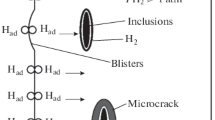Abstract
Threshold stress intensities, KTH, below which no cracking will occur under stress-corrosion cracking or hydrogen-assisted cracking conditions, are discussed. A quantitative correlation, which suggests why KTH may exist, is evolved. The controlling mechanism is proposed to be a critical concentration of hydrogen, its propensity to form being governed by yield strength, initial concentration, state of stress and temperature variables. The general trends of all variables are reviewed for high strength AISI 4340, maraging and 9 Ni4 Co steels. Specifically it is proposed that Kapplied=KTHCeq=Ccr which means that the applied stress intensity equals the threshold when the equilibrium concentration of hydrogen at the crack tip just achieves the critical concentration. Based upon this concept, correlations are derived for elastic, plane-strain plastic and plane-stress plastic conditions.
Similar content being viewed by others
References
C. Zapffe and C. Sims:Trans. AIME, 1941, vol. 145, p. 225.
H. H. Johnson, J. G. Morlet and A. R. Troiano:Trans. TMS-AIME, 1958, vol. 212, p. 528.
R. P. Frohmberg, W. J. Barnett and A. R. Troiano:Trans. ASM, 1955, vol. 47, p. 892.
E. A. Steigerwald, F. W. Schaller and A. R. Troiano:Trans. TMS-AIME, 1959, vol. 215, p. 1048.
A. R. Troiano:Trans. ASM, 1960, vol. 52, p. 54.
H. H. Johnson:Fundamental Aspects of Stress Corrosion Cracking, p. 439, Nat. Assoc. Corros. Engrs., Houston, 1969.
A. S. Tetelman and A. J. McEvily, Jr.:Fracture of Structural Materials, John Wiley and Sons, 1967.
N. O. Petch and P. Stables:Nature, 1952, vol. 169, p. 842.
H. Uhlig:Physical Metallurgy of Stress Corrosion Fracture, p. 1, Interscience, New York, 1959.
A. S. Tetelman:Fundamental Aspects of Stress Corrosion Cracking, p. 446, Nat. Assoc. Corros. Engrs., Houston, 1969.
H. W. Liu:J. Basic Eng., ASME, 1970, vol. 92, p. 633.
R. P. Harrison, P. T. Heald and J. A. Williams:Scripta Met., 1971, vol. 5, p. 543.
St. John and W. W. Gerberich:Met. Trans., 1973, vol. 4, p. 589.
B.C. Syrett:Corrosion, 1973, vol. 29, no. 1, p. 23.
H. P. Van Leevwen:Corrosion, 1973, vol. 29, no. 5, p. 197.
R. A. Oriani:Ber. Bunsenges. Phys. Chem., 1972, vol. 76, no. 8, p. 848.
R. A. Oriani and P. H. Josephic:Scripta Met., 1972, vol. 6, p. 681.
M. H. Peterson, B. F. Brown, R. L. Newbegin and R. F. Groover:Corrosion, 1967, vol. 23, p. 142.
G. G. Hancock and H. H. Johnson:Trans. TMS-AIME, 1966, vol. 236, p. 513.
H. H. Johnson:Fracture, Vol. III, ed by H. Liebowitz, p. 705, Academic Press, 1971.
S. Carter:J. Eng. Fract. Mech., 1971, vol. 3, no. 1, p. 1.
S. Carter:Corrosion, 1971, vol. 27, no. 11, p. 471.
S. Carter:Corrosion, 1969, vol. 25, no. 10, p. 423.
B. F. Brown:The Theory of Stress Corrosion Cracking in Alloys, J. Scully, ed., p. 186, NATO, Brussels, W. S. Maney and Son, Leeds, England, 1971.
G. Sandoz: ibid, personal communication to B. F. Brown.
B. F. Brown:Stress-Corrosion-Cracking-A State of the Art, p. 3, ASTM STP 518, Philadelphia, 1972.
H. E. Townsend, Jr.: ibid., ASTM STP 518, Philadelphia, 1972 p. 155.
W. D. Benjamin and E. A. Steigerwald: Air Force Materials Laboratory Report TR-68-80, 1968.
S. Mostovoy, H. R. Smith, R. G. Lingwall and E. J. Ripling:J. Eng. Fract. Mech, 1971, vol. 3, p. 291.
E. H. Phelps:Fundamental Aspects of Stress Corrosion Cracking, Staehle, Forty, and Van Rooyen, eds., Nat. Assoc. Corros. Engrs., 1969, p. 398.
E. T. Wessel:J. Eng. Fract. Mech., 1968, vol. 1, p. 77.
F. Barth and E. A. Steigerwald:Met. Trans., 1970, vol. 1, p. 3451.
W. W. Gerberich and C. E. Hartbower:Fundamental Aspects of Stress Corrosion Cracking, p. 420, Nat. Assoc. Corros. Engrs., Houston, 1969.
A. H. Cottrell,Dislocations and Plastic Flow in Crystals, Clarendon Press, Oxford, 1953.
R. A. Oriani:Fundamental Aspects of Stress Corrosion Cracking, p. 32, Nat. Assoc. of Corros. Engrs., Houston, 1969.
J. M. Li, R. A. Oriani and L. S. Darken:Z. Physik. Chem., 1966, vol. 49, p. 271.
J. C. M. Li: private communication in Ref. 35.
F. A. McClintock and G. R. Irwin:Fracture Toughness Testing, p. 84, ASTM STP 381, Philadelphia, 1965.
D. Beachem:Met. Trans., 1972, vol. 3, p. 437.
A. J. Wang:Quart, Appl. Mech., 1954, vol. 11, p. 427.
J. L. Swedlow:Int. J. Fract. Mech., 1969, vol. 5, no. 1, p. 33.
J. W. Hutchinson:J. Mech. Phys. Solids, 1968, vol. 16, p. 13.
G. T. Hahn and A. R. Rosenfield:Trans. ASM, 1966, vol. 59, p. 909.
J. M. Krafft: Report of Naval Research Laboratory Program, January, 1966.
K. Farrell and A. G. Quarrell:J. Iron Steel Inst., 1964, vol. 202, p. 102.
D. Kim and A. W. Loginow:Corrosion, 1968, vol. 24, no. 10, p. 313d.
Author information
Authors and Affiliations
Additional information
This present paper is based on a portion of the thesis submitted by Y. T. Chen in partial fulfillment of the requrirement for the M.S.degeee at the University of Minnesota.
Rights and permissions
About this article
Cite this article
Gerberich, W.W., Chen, Y.T. Hydrogen-controlled cracking—An approach to threshold stress intensity. Metall Trans A 6, 271 (1975). https://doi.org/10.1007/BF02667281
Received:
DOI: https://doi.org/10.1007/BF02667281



